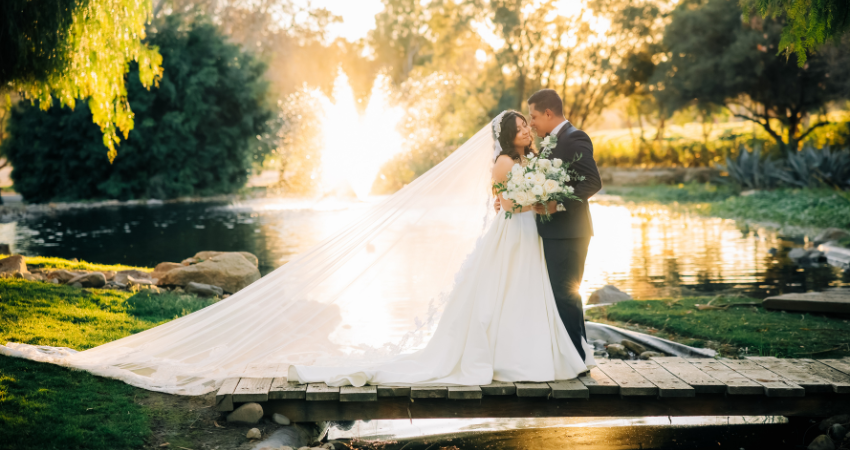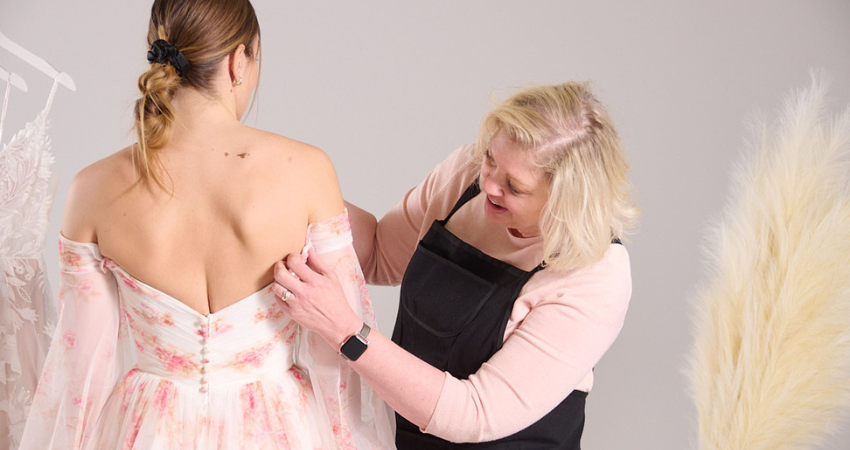2019 Satin Wedding Dresses for a Shimmery, Sophisticated, and Regal Look

Ballet-inspired brides, glamorous brides, vintage-inspired brides… brides everywhere will love our brand new 2019 satin wedding dresses for a unique and lustrous look on their wedding days. A lace wedding dress is lovely and organza is full of body, but satin is unmatched when it comes to marking the distinction and elegance of your big day. Read on for the our favorite 2019 satin wedding dresses for a shimmery, sophisticated, and regal Look.
What is Satin?
A gown is “satin” if it has a specific fabric and weave pattern. The top side of this fabric is glossy and smooth, while the underside is dull and matte. It’s also possible to purchase double-faced satin for gloss on both sides. Traditionally satin is made from silk, but modern variations are typically made with polyester, nylon, or rayon.
Satin fabric is used to make bedding, ballet slippers, lingerie, and clothing. Medieval-Age royalty and aristocracy coveted the expensive fabric; today’s designers love its luxurious and sensual feel.
Various satin fabrics are available in designer wedding gowns:
- Crepe-back satin: Like standard satin, crepe-back satin has a shiny side and matte side. But with crepe-back variations, the matte texture is more often the focus.
- Antique satin: Another reversible fabric, antique satin has more texture than standard satin, visually and tactilely.
- Antique satin is easily damaged, so must only be cleaned by an expert.
- Charmeuse: Soft, silky, and lightweight, charmeuse is the most fluid type of satin.
- Duchess satin: With a high thread count and durable weave, duchess satin offers the best foundation for embellishments, pleats, and structural details.
- Peau de Soie: Another name for duchess satin, featuring a structured, semi-gloss texture.
 |
 |
 |
 |
Silk vs. Sateen
Whereas satin is made with silk, rayon, polyester, and nylon, sateen is a cotton-based fabric. The fabrics are woven the same way, but sateen gets its gloss from a chemical process called mercerization. Sateen is more durable from a construction standpoint, but doesn’t achieve the same gloss as satin, and the sheen tends to fade after wearing and washing. Luxury garments are made with satin more often than sateen.
Consider Your Options
While satin is an opulent and high-quality fabric, many brides prefer lightweight alternatives like taffeta and organza. Consider your taste and comfort level: satin is formal, iridescent, and unique, but some satin gowns can feel hot and heavy in the wrong environment. Furthermore, many brides prefer subtle to no shine in their gowns, opting for matte organza and antique lace over shimmery fabrics. Don’t be afraid to ask questions and follow your instincts when it comes to finding the perfect gown.
Find Your Style of Satin Wedding Dress
If you’ve fallen in love with satin fabric, consider the design, silhouette, and embellishments on your dreamy satin wedding dress.
Satin fabric pairs beautifully with Old Hollywood-inspired silhouettes like strapless fit-and-flares and off-the-shoulder sheaths. A ballgown silhouette evokes fairytale romance and Old World drama, while classic A-lines allow the fabric to speak for itself.
 |
 |
 |
 |
Modern brides are seeking simple satin wedding dresses that highlight the fabric’s shimmer and dimension. On the other hand, an exceptional gown accented in pearls, beading, and Swarovski crystals gives a lavish and sophisticated air to your occasion. So, if “statement bridal” is your mantra, embellished satin will make you feel like a star.
 |
 |
Finally, customize your satin wedding dress with separates and accessories. Detachable tulle overskirts add a unique contrast and layering to satin fabric, while jackets, capelets, and veils offer demure coverage and intriguing detail.
 |
 |
Keep It Clean! Caring for Your Satin Wedding Gown
Whether you’ve chosen a simple or elaborate design, preserving the beauty of your satin wedding dress depends on simple but diligent aftercare. While we recommend only taking your wedding dress to a professional dry cleaner for a full treatment, spot-cleaning your gown is easy and inexpensive to do at home.
Here’s what you’ll need:
Soft, clean rags or dishcloths
Mild dish soap
Mild liquid soap
A stain removal product, such as Grandma’s Secret Spot Remover
Once you’ve gathered your materials, do a quick spot-clean on your dress, saving grease stains for a special treatment later. Use warm water and a dab of mild liquid soap to treat dark spots, dirt stains, and non-greasy food stains. Use a spot removal product, such as Grandma’s Secret, to treat wine and makeup stains. Rub with a soft, clean rag, but don’t scrub.
Treat grease stains by squirting a little dishwashing soap on a soft, clean rag and applying it to the fabric. Blot to begin, then scrub gently as necessary. The soap will eventually lift the grease away. Neglecting to spot clean will let these grease stains set, making it much more difficult to clean later.
When you take your dress to a professional dry cleaner, be sure they remove all attachments on your wedding dress, including detachable florals, appliqués, and beaded accessories, to prevent damage during the cleaning process. Do your research before settling on a professional service; your Authorized Retailer is an excellent resource for recommendations.
De-Wrinkling Your Satin Wedding Dress
Set your iron on the lowest setting, and don’t neglect the steam! Dry heat could melt your high-quality gown in seconds flat.
Iron your dress inside out with a thin cotton cloth between the satin and iron. Do not put the iron directly on the satin fabric. Test your method in a small, hidden area first.
If running an iron on your satin dress intimidates you, try a steaming method. Hang the gown in your bathroom, run a hot shower, and close the door to allow steam to build up. Check to see if the wrinkles are gone after twenty or so minutes. You may need to smooth out the fabric with a clean cloth or cotton glove and let the shower run a little longer.















